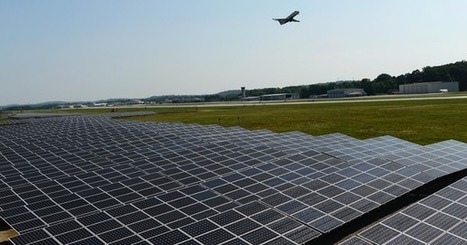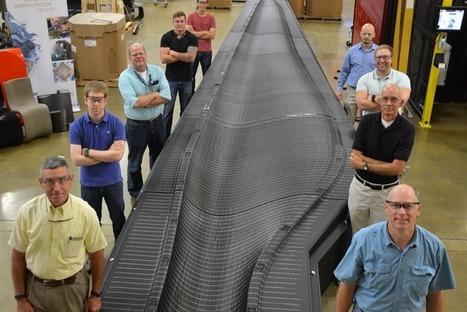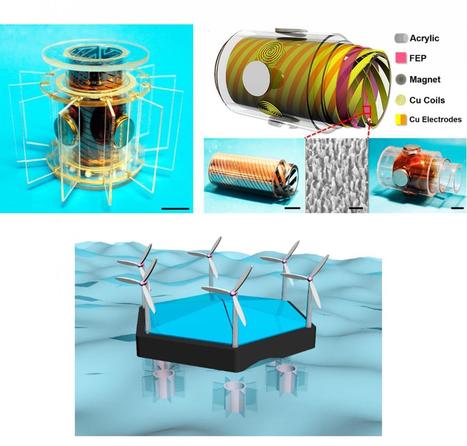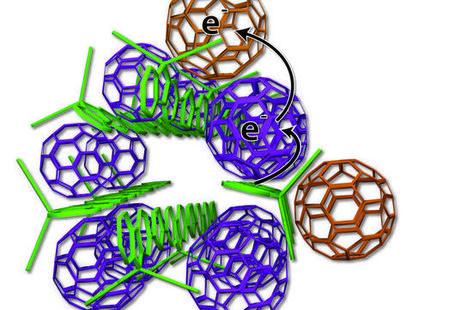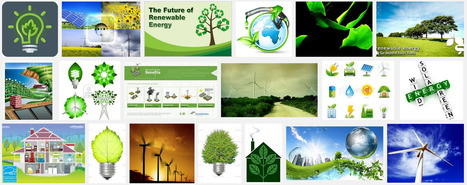 Your new post is loading...
A futuristic demonstration of emerging renewable energy material – printed solar cells, is being trialled in a public setting for the first time as it nears commercial readiness. Creator of the organic printed solar material, Physicist Professor Paul Dastoor from the Faculty of Science said his team were excited to take their ‘science to the streets’ in what represented significant progress toward commercial availability of the material. “Globally, there’s been so few of these installations, we know very little about how they perform in a public setting. This installation is the next critical step in accelerating the development and commercialization of this technology. It presents a new scenario for us to test performance and durability against a range of new challenges,” said Professor Dastoor. “Located within Lane Cove Council’s vibrant new urban space ‘The Canopy’, this demonstration plucks extraordinary science from behind sealed lab doors, and places it in an ordinary environment, where people will interact with it as they go about their grocery shopping, play with their children in the park, or enjoy food in one of the nearby restaurants. It’s an effortless and subtle way to spark conversation and showcase ‘what’s next’ in energy generation to thousands of people.” The renewable energy tech - which is ultra light-weight, ultra flexible, recyclable and cheap to manufacture, will power interactive public lighting in Sydney. Professor Dastoor said he was hopeful the public installation would prompt further discussion on the subject of energy as the Federal Government considered submissions to its technology investment roadmap. "The government is seeking to bring down carbon emissions over the next 30 years and the community has been very engaged on this subject. Globally, there are many research groups like ours working on sustainable energy technologies and now, via the technology investment roadmap, is our opportunity to ensure we invest in and deliver clever solutions,” said Professor Dastoor. Director of the University’s Newcastle Institute for Energy and Resources (NIER), Professor Alan Broadfoot, said the University was committed to bringing the world closer to a sustainable future through its next generation resources engagement priority. “The printed solar project highlights the transformational research coming out of NIER through valued partnerships with government, industry, and the community in critical areas such as new energy technologies,” said Professor Broadfoot. A new advanced manufacturing industry for Australia This installation follows a successful commercial-scale public sector installation with CHEP in late 2018. Professor Dastoor said global interest in printed solar was the highest he had ever witnessed and that an advanced manufacturing facility for printed solar in NSW was the imminent goal for his team. “We have a world-class manufacturing facility at the University’s Newcastle Institute for Energy and Resources (NIER), which has been generously supported by the Australian National Fabrication Facility (ANFF). This print facility can manufacture hundreds of meters of material a day, however we’re now reaching the point where we need to significantly scale this level of production,” said Professor Dastoor. This technology will really disrupt and revitalise the contracting print industry. Printed solar is manufactured on conventional printers – our lab-scale system previously manufactured wine labels.
The Chattanooga Metropolitan Airport has announced the completion of a solar farm that can power 100% of its daily energy needs. It's the first airport in America to do so. Chattanooga's been having quite a cultural moment recently, what with dozens of new restaurants and bars popping up across town. Last September,The Edwin Hotel, a member of The Autograph Collection, opened with much fanfare, joining The Dwell and The Moxy Chattanooga Downtown in The Scenic City's growing boutique hotel scene. Now, Tennessee's fourth-largest city is once again turning heads by claiming a first in the sustainability sector. Earlier this month, the Chattanooga Metropolitan Airport announced that it had hit a much-anticipated milestone in becoming the first airfield in the United States powered by 100% solar energy. The end result of an ambitious project that started seven years ago, the airport's 2.64-megawatt solar farm was completed with about $5 million of funding from the Federal Aviation Administration. That investment is expected to be earned back in under 20 years, as a renewable energy stream brings down the facility's overall costs of operation. According to a press release, the installation measures about the size of 16 football fields—eight long and two wide. “This is a momentous day for the Chattanooga Airport as we complete our solar farm and achieve a major sustainability milestone,” said Terry Hart, president and CEO of the Chattanooga Airport in the release. “This project has immediate benefits to our airport and community, and we’re proud to set an example in renewable energy for other airports, businesses and our region. While generating a local renewable resource, we are also increasing the economic efficiency of the airport.” According to Bloomberg, Chattanooga Airport's solar farm saves energy via storage units that allow operations to continue after sundown. The publication also reports that the system is expected to last between 30 and 40 years. It's worth pointing out that Chattanooga Airport's operation is relatively small, with direct flights to just ten cities including Chicago, Dallas, and New York City via Allegiant, American, Delta, and United Airlines. Still, the airport saw growth in traffic in 2018, with an increase of 4% from the previous year for total of 504,298 passengers. Furthermore, the success of the project could inspire similar endeavors across the nation—already, solar grids are in place at Denver International Airport and Indianapolis International Airport, whose solar farm is the largest in the country. Globally, Chattanooga Airport joins the likes of South Africa's George Airport, The Galapagos' Seymour Airport, and most impressively, India's Cochin International Airport, which became the world's first solar-powered airport back in 2015. Using a 12-megawatt plant, the airport operates 1,000 weekly flights for 27 airlines, serving 10 million passengers annually. Meanwhile Spain's airport operator, Aena, earlier this year approved a $280 million plan to install solar panels in half of its airports.
A solar panel that can generate electricity from falling raindrops has been invented, enabling power to flow even when skies cloud over or the sun has set. Solar power installation is soaring globally thanks to costs plunging 90% in the past decade, making it the cheapest electricity in many parts of the world. But the power output can plummet under grey skies and researchers are working to squeeze even more electricity from panels. The new device, demonstrated in a laboratory at Soochow University in China, places two transparent polymer layers on top of a solar photovoltaic (PV) cell. When raindrops fall on to the layers and then roll off, the friction generates a static electricity charge. “Our device can always generate electricity in any daytime weather,” said Baoquan Sun, at Soochow University. “In addition, this device even provides electricity at night if there is rain.” Other researchers have recently created similar devices on solar panels, known as triboelectric nanogenerators (Tengs), but the new design is significantly simpler and more efficient as one of the polymer layers acts as the electrode for both the Teng and the solar cell. “Due to our unique device design, it becomes a lightweight device,” said Sun, whose team’s work is published in the journal ACS Nano. “In future, we are exploring integrating these into mobile and flexible devices, such as electronic clothes. However, the output power efficiency needs to be further improved before practical application.”
Physicists at the U.S. Department of Energy’s Princeton Plasma Physics Laboratory (PPPL)* are building a “star in a jar” — a miniature version of the how our Sun creates energy through fusion. It could provide humankind with near limitless energy, ending dependence on fossil fuels for generating electricity — without contributing greenhouse gases that warm the Earth, and with no long-term radioactive waste. But that requires a “jar” that can contain superhot plasma — and is low-cost enough to be built around the world. A model for such a “jar,” or fusion device, already exists in experimental form: the tokamak, or fusion reactor. Invented in the 1950s by Soviet physicists, it’s a device that uses a powerful magnetic field to confine plasma (superhot charged gas) in the shape of a torus. There are many experimental tokamaks currently in operation, but they all face physics challenges, the PPPL physicists explain. “For example, they must control the turbulence that arises when superhot plasma particles are subjected to powerful electromagnetic fields. They must also carefully control how the plasma particles interact with the surrounding walls to avoid possible disruptions that can halt fusion reactions if the plasma becomes too dense or impure.” So researchers at PPPL and in and Culham, England are looking at ways of solving these challenges for the next generation of fusion devices, based on compact spherical tokamaks. They suggest that these could provide the design for possible next steps in fusion energy: a Fusion Nuclear Science Facility (FNSF) that would develop reactor components and also produce electricity as a pilot plant for a commercial fusion power station. The detailed proposal for such a “jar” is described in a paper published in August 2016 in the journal Nuclear Fusion. “We are opening up new options for future plants,” said lead author Jonathan Menard, program director for the recently completed National Spherical Torus Experiment-Upgrade (NSTX-U) at PPPL. The $94-million upgrade of the NSTX, financed by the U.S. Department of Energy’s Office of Science, began operating last year. Spherical tokamaks are compact devices shaped like cored apples, compared with the bulkier doughnut-like shape of conventional tokamaks. The increased power of the upgraded PPPL machine and the soon-to-be completed MAST Upgrade device “will push the physics frontier, expand our knowledge of high temperature plasmas, and, if successful, lay the scientific foundation for fusion development paths based on more compact designs,” said PPPL Director Stewart Prager.
This isn’t something oil markets are planning for, and it’s easy to see why. Plug-in cars make up just one-tenth of 1 percent of the global car market today. They’re a rarity on the streets of most countries and still cost significantly more than similar gasoline burners. OPEC maintains that electric vehicles (EVs) will make up just 1 percent of cars in 2040. Last year ConocoPhillips Chief Executive Officer Ryan Lance told me EVs won’t have a material impact for another 50 years—probably not in his lifetime.
But here’s what we know: In the next few years, Tesla, Chevy, and Nissan plan to start selling long-range electric cars in the $30,000 range. Other carmakers and tech companies are investing billions on dozens of new models. By 2020, some of these will cost less and perform better than their gasoline counterparts. The aim would be to match the success of Tesla’s Model S, which now outsells its competitors in the large luxury class in the U.S. The question then is how much oil demand will these cars displace? And when will the reduced demand be enough to tip the scales and cause the next oil crisis?
Iceland runs on 100 percent sustainable energy. The country has taken advantage of vast natural geothermal resources to harness power from hot water reserves underground. This water is so clean that hundreds of thousands of people each year bathe in the island's thermal baths. But the small European nation is also windy. It is too windy, in fact, for traditional wind turbines, which spin out of control. So inside a former coal plant, work was underway on a new renewable energy concept, reports CBS News correspondent Jonathan Vigliotti.
"The more simple the system the longer it lasts," said inventor Saethor Asgeirsson. He has developed a unique turbine called the CW1000. This new turbine's precisely engineered, curved blades mean that, as strong winds hit it from one side, it both catches and goes against the force at the same time. The result is a turbine that can slow itself down without needing expensive mechanical brakes that often fail in traditional turbines in high wind.
And while it might seem odd that entrepreneurs in a country that already powers itself sustainably are working on developing other renewable energy technologies, Jonas Ketlisson of Iceland's National Energy Authority explained that there is always room for innovation.
"After our financial crisis that we encountered a few years back, people had to rethink and restructure," Ketlisson said. "I think it did bring us a lot of good ideas. Those ideas could grow into something big." And thinking big is something Saethor Asgeirson hopes to do, Vigliotti reports, when he exports his green energy to the wider European market and other parts of the world.
Via Leonardo Wild
In an engineering first, Stanford University scientists have invented a low-cost water splitter that uses a single catalyst to produce both hydrogen and oxygen gas 24 hours a day, seven days a week. The researchers believe that the device, described in anopen-access study published today (June 23) in Nature Communications, could provide a renewable source of clean-burning hydrogen fuel for transportation and industry.
“We have developed a low-voltage, single-catalyst water splitter that continuously generates hydrogen and oxygen for more than 200 hours, an exciting world-record performance,” said study co-author Yi Cui, an associate professor of materials science and engineering at Stanford and of photon science at the SLAC National Accelerator Laboratory.
Hydrogen has long been promoted as an emissions-free alternative to gasoline. But most commercial-grade hydrogen is made from natural gas — a fossil fuel that contributes to global warming. So scientists have been trying to develop a cheap and efficient way to extract pure hydrogen from water.
A conventional water-splitting device consists of two electrodes submerged in a water-based electrolyte. A low-voltage current applied to the electrodes drives a catalytic reaction that separates molecules of H2O, releasing bubbles of hydrogen on one electrode and oxygen on the other.
In these devices, each electrode is embedded with a different catalyst, typically platinum and iridium, two rare and costly metals. But in 2014, Stanford chemist Hongjie Dai developed a water splitter made of inexpensive nickel and iron that runs on an ordinary 1.5-volt battery.
In conventional water splitters, the hydrogen and oxygen catalysts often require different electrolytes with different pH — one acidic, one alkaline — to remain stable and active. “For practical water splitting, an expensive barrier is needed to separate the two electrolytes, adding to the cost of the device,” Wang explained.
“Our water splitter is unique because we only use one catalyst, nickel-iron oxide, for both electrodes,” said graduate student Haotian Wang, lead author of the study. “This bi-functional catalyst can split water continuously for more than a week with a steady input of just 1.5 volts of electricity. That’s an unprecedented water-splitting efficiency of 82 percent at room temperature.”
Wang and his colleagues discovered that nickel-iron oxide, which is cheap and easy to produce, is actually more stable than some commercial catalysts made of expensive precious metals. The key to making a single catalyst possible was to use lithium ions to chemically break the metal oxide catalyst into smaller and smaller pieces. That “increases its surface area and exposes lots of ultra-small, interconnected grain boundaries that become active sites for the water-splitting catalytic reaction,” Cui said. “This process creates tiny particles that are strongly connected, so the catalyst has very good electrical conductivity and stability.”
It’s the holy grail in energy production: produce a fuel that is both carbon neutral and can be poured directly into our current cars without the need to retrofit. There are scores of companies out there trying to do just that using vegetable oil, algae, and even the microbes found in panda poop to turn bamboo into fuel.
This week, German car manufacturer Audi has declared that they have been able to create an "e-diesel," or diesel containing ethanol, by using renewable energy to produce a liquid fuel from nothing more than water and carbon dioxide. After a commissioning phase of just four months, the plant in Dresden operated by clean tech company Sunfire has managed to produce its first batch of what they’re calling “blue crude.” The product liquid is composed of long-chain hydrocarbon compounds, similar to fossil fuels, but free from sulfur and aromatics and therefore burns soot-free.
The first step in the process involves harnessing renewable energy through solar, wind or hydropower. This energy is then used to heat water to temperatures in excess of 800˚C (1472˚F). The steam is then broken down into oxygen and hydrogen through high temperature electrolysis, a process where an electric current is passed through a solution.
The hydrogen is then removed and mixed with carbon monoxide under high heat and pressure, creating a hydrocarbon product they’re calling "blue crude." Sunfire claim that the synthetic fuel is not only more environmentally friendly than fossil fuel, but that the efficiency of the overall process—from renewable power to liquid hydrocarbon—is very high at around 70%. The e-diesel can then be either mixed with regular diesel, or used as a fuel in its own right.
But all may not be as it seems. The process used by Audi is actually called the Fischer-Tropsch process and has been known by scientists since the 1920s. It was even used by the Germans to turn coal into diesel during the Second World War when fuel supplies ran short. The process is currently used by many different companies all around the world, especially in countries where reserves of oil are low but reserves of other fossils fuels, such as gas and coal, are high.
And it would seem that Audi aren’t the first to think about using biogas facilities to produce carbon neutral biofuels either. Another German company called Choren has already made an attempt at producing biofuel using biogas and the Fischer-Tropsch process. Backed by Shell and Volkswagen, the company had all the support and funding it needed, but in 2011 it filed for bankruptcy due to impracticalities in the process.
Audi readily admits that none of the processes they use are new, but claim it’s how they’re going about it that is. They say that increasing the temperature at which the water is split increases the efficiency of the process and that the waste heat can then be recovered. Whilst their announcement might not be heralding a new fossil fuel-free era, the tech of turning green power into synthetic fuel could have applications as a battery to store excess energy produced by renewables.
Microalgae-based biofuel not only has the potential to quench a sizable chunk of the world's energy demands, say Utah State University researchers. It's a potential game-changer.
"That's because microalgae produces much higher yields of fuel-producing biomass than other traditional fuel feedstocks and it doesn't compete with food crops," says USU mechanical engineering graduate student Jeff Moody.
With USU colleagues Chris McGinty and Jason Quinn, Moody published findings from an unprecedented worldwide microalgae productivity assessment in the May 26, 2014 Edition of the Proceedings of the National Academy of Sciences. The team's research was supported by the U.S. Department of Energy.
Despite its promise as a biofuel source, the USU investigators questioned whether "pond scum" could be a silver bullet-solution to challenges posed by fossil fuel dependence.
"Our aim wasn't to debunk existing literature, but to produce a more exhaustive, accurate and realistic assessment of the current global yield of microalgae biomass and lipids," Moody says.
With Quinn, assistant professor in USU's Department of Mechanical and Aerospace Engineering, and McGinty, associate director of USU's Remote Sensing/Geographic Information Systems Laboratory in the Department of Wildland Resources, Moody leveraged a large-scale, outdoor microalgae growth model. Using meteorological data from 4,388 global locations, the team determined the current global productivity potential of microalgae.
Algae, he says, yields about 2,500 gallons of biofuel per acre per year. In contrast, soybeans yield approximately 48 gallons; corn about 18 gallons.
"In addition, soybeans and corn require arable land that detracts from food production," Quinn says. "Microalgae can be produced in non-arable areas unsuitable for agriculture."
The researchers estimate untillable land in Brazil, Canada, China and the U.S. could be used to produce enough algal biofuel to supplement more than 30 percent of those countries' fuel consumption.
The growing number of plug-in electric cars — more than 96,000 bought in 2013 — may put a lot of new strain on the nation’s aging electrical distribution systems, like transformers and underground cables, especially at times of peak demand, according to University of Vermont (UVM) scientists. So they have created a novel solution, which they report on in the forthcoming March issue of IEEE Transactions on Smart Grid.
“The key to our approach is to break up the request for power from each car into multiple small chunks — into packets,” says Jeff Frolik, a professor in the College of Engineering and Mathematical Sciences and co-author on the new study. This is similar to transmitting data packets on the Internet.
By using the nation’s growing network of “smart meters” — a new generation of household electric meters that communicate information back-and-forth between a house and the utility — the new approach would let a car charge for, say, five or ten minutes at a time, Frolik says, and then wait to make another request for power. If demand was low, it would continue charging, but if it was high, the car would have to wait.
“Most of the time, as long as people get charged by morning, they won’t care,” says UVM’s Paul Hines, an expert on power systems and co-author on the study. “By charging cars in this way, it’s really easy to let everybody share the capacity that is available on the grid.”
Redox Power Systems, a Fulton, MD-based start-up company founded last year, sealed the deal on a partnership with researchers at the University of Maryland to commercialize a potentially game-changing distributed generation technology. Redox says that it plans to bring to market a fuel cell that is about one-tenth the size and one-tenth the cost of currently commercial fuel cells by 2014. The breakthrough solid oxide fuel cell technology is the brainchild of Eric Wachsman, the director of the University of Maryland’s Energy Research Center. Redox says that it will provide safe, efficient, reliable, uninterrupted power, on–site and optionally off the grid, at a price competitive with current energy sources. The promise is this: generate your own electricity with a system nearly impervious to hurricanes, thunderstorms, cyber attacks, derechos, and similar dangers, while simultaneously helping the environment. “Every business or home should be able to safely generate its own energy,” said Warren Citrin, CEO and director of Redox. “We currently rely upon a vulnerable electrical grid. The best way to decrease that vulnerability is through distributed energy, that is, by making your own energy on-site. We are building systems to do that, with an emphasis on efficiency and affordability. These should be common appliances.” Redox’s PowerSERG 2-80, also called “The Cube,” connects to your natural gas line and electrochemically converts methane to electricity. The first generation has a nameplate capacity of 25 kilowatts, which can power a gas station or small grocery store, and is roughly the size of a dishwasher. The system can run at an 80% efficiency when used to provide both heat and power.
Via Sepp Hasslberger
Using a simple solar cell and a photo anode made of a metal oxide, HZB and TU Delft scientists have successfully stored nearly five percent of solar energy chemically in the form of hydrogen. This is a major feat as the design of the solar cell is much simpler than that of the high-efficiency triple-junction cells based on amorphous silicon or expensive III-V semiconductors that are traditionally used for this purpose.
The photo anode, which is made from the metal oxide bismuth vanadate (BiVO4) to which a small amount of tungsten atoms was added, was sprayed onto a piece of conducting glass and coated with an inexpensive cobalt phosphate catalyst. "Basically, we combined the best of both worlds," explains Prof. Dr. Roel van de Krol, head of the HZB Institute for Solar Fuels: "We start with a chemically stable, low cost metal oxide, add a really good but simple silicon-based thin film solar cell, and – voilà – we've just created a cost-effective, highly stable, and highly efficient solar fuel device."
Thus the experts were able to develop a rather elegant and simple system for using sunlight to split water into hydrogen and oxygen. This process, called artificial photosynthesis, allows solar energy to be stored in the form of hydrogen. The hydrogen can then be used as a fuel either directly or in the form of methane, or it can generate electricity in a fuel cell. One rough estimate shows the potential inherent in this technology: At a solar performance in Germany of roughly 600 Watts per square meter, 100 square meters of this type of system is theoretically capable of storing 3 kilowatt hours of energy in the form of hydrogen in just one single hour of sunshine. This energy could then be available at night or on cloudy days.
Scientists from the University of Manchester have discovered a material which combines graphene, a one-atom thick layer of graphite, with the transition metal dichalcogenides. Something straight out of a science fiction film is fastly becoming an exciting reality as scientists from the University of Manchester have discovered a material which combines graphene, a one-atom thick layer of graphite, with the transition metal dichalcogenides. The material is thin and flexible, and it can absorb sunlight to produce electricity at the same rates of existing solar panels. This could be potentially used to coat the outside of buildings to generate power required to run appliances inside.
The material is composed of transition metal dichalcogenides layers sandwiched between the two outer layers of graphene. The graphene acts as an extremely efficient conductive layer, and the TMDC acts as a very sensitive light absorber. Researchers have found that the 'light absorption characteristic' of the material can be increased when the graphene layer is sprinkled with gold particles. The material has a quantum efficiency of 30%. Researchers believe that entire buildings could be powered by coating their exposed surfaces with the panels. Further, the energy produced by the panels could be used to alter the transparency and reflectivity of windows and fixtures. This type of graphene material could be used to form on the outside of the buildings to generate power required to run the appliances inside. It is flexible and easy to use. Not only can graphene paint be used to power objects, the material will also be able to chaneg color. Researchers also believe that the graphene base substance has the ability to create a new generation of hand-held devices such as smartphones that can be powered using sunlight. These devices can be made ultra-thin, transparent and flexible. Research suggests that there can be a high level of optimism regarding the development of graphene in the near future. They hope that the material can be used for a wide range of industrial and day-to-day applications, providing potential technological breakthroughs in the areas, right from electronics to telecommunications and energy generation.
|
Changing climate patterns have left millions of people vulnerable to weather extremes. As temperature fluctuations become more commonplace around the world, conventional power-guzzling cooling and heating systems need a more innovative, energy-efficient alternative, and in turn, lessen the burden on already struggling power grids. In a new study, researchers at Texas A&M University have created novel 3D printable phase-change material (PCM) composites that can regulate ambient temperatures inside buildings using a simpler and cost-effective manufacturing process. Furthermore, these composites can be added to building materials, like paint, or 3D printed as decorative home accents to seamlessly integrate into different indoor environments. "The ability to integrate phase-change materials into building materials using a scalable method opens opportunities to produce more passive temperature regulation in both new builds and already existing structures," said Dr. Emily Pentzer, associate professor in the Department of Materials Science and Engineering and the Department of Chemistry. Dr. Emily Pentzer and her team have created novel 3D printable phase-change material composites that can regulate ambient temperatures inside buildings using a simpler and cost-effective manufacturing process. This study was published in the June issue of the journal Matter. Heating, ventilation and air conditioning (HVAC) systems are the most commonly used methods to regulate temperatures in residential and commercial establishments. However, these systems guzzle a lot of energy. Furthermore, they use greenhouse materials, called refrigerants, for generating cool, dry air. These ongoing issues with HVAC systems have triggered research into alternative materials and technologies that require less energy to function and can regulate temperature commensurate to HVAC systems. One of the materials that have gained a lot of interest for temperature regulation is phase-change materials. As the name suggests, these compounds change their physical state depending on the temperature in the environment. So, when phase-change materials store heat, they convert from solid to liquid upon absorbing heat and vice versa when they release heat. Thus, unlike HVAC systems that rely solely on external power to heat and cool, these materials are passive components, requiring no external electricity to regulate temperature.
In collaboration with Oak Ridge National Laboratory's Manufacturing Demonstration Facility Team and turbine blade manufacturer TPI Composites, Sandia National Laboratories 3D printed a massive mold to produce wind turbine blades. Sandia researchers have been working on wind turbines for the better part of 40 years; it’s part of the lab's effort to make the renewable energy more affordable. However, building wind turbine prototypes takes a lot of time and effort, and each requires custom molds that take up to 16 months to complete before the blade can be developed and tested. Through the use of 3D printing, the team was able to cut mold development time by more than 80 percent, going from 16 months of development time down to 3 months. The work cut out more than a year of labor. The 13-meter blade mold is relatively small compared to other blades currently on the market and under development — for example, GE's Haliade-X blades will be 107 meters long. However, by cutting design and development time and cost, engineers could take greater risks during the prototype phase that could potentially accelerate innovation in the market.
Via Alan Charky
The renewable energy future will arrive when installing a new solar panels is cheaper than a comparable investment in coal, natural gas or other options. If you ask the World Economic Forum (WEF), the day has arrived. Solar and wind is now the same price or cheaper than fossil fuels in more than 30 countries, the WEF reported in December (pdf). As prices for solar and wind power continue their precipitous fall, two-thirds of all nations will reach the point known as “grid parity” within a few years, even without subsidies. “Renewable energy has reached a tipping point,” Michael Drexler, who leads infrastructure and development investing at the WEF, said in a statement. “It is not only a commercially viable option, but an outright compelling investment opportunity with long-term, stable, inflation-protected returns.” Those numbers are already translating into vast new acres of silicon and glass. In 2016, utilities added 9.5 gigawatts (GW) of photovoltaic capacity to the US grid, making solar the top fuel source for the first time in a calendar year, according to the US Energy Information Administration’s estimates. The US added about 125 solar panels every minute in 2016, about double the pace last year, reports the Solar Energy Industry Association.
Energy from the ocean, or "blue energy," is arguably the most underexploited power source, according to researchers in a new study. The main problem is that ocean waves are irregular and pass by at low frequencies, whereas most energy harvesters operate best with waves that have regular amplitudes and high frequencies. Unfortunately, the calming lull of slow, unpredictable waves beating against the shore that we tend to find so peaceful is not ideal for energy harvesting. In a new study published in ACS Nano, a team of researchers led by Zhong Lin Wang at the Georgia Institute of Technology has developed a device that can harvest ocean waves in a very broad frequency range that encompasses almost all of the ocean wave energy spectrum, including the hard-to-reach low frequencies that are inaccessible to most harvesters. The new device is a hybrid system that consists of two generators. An electromagnetic generator (EMG), which has traditionally been the main approach for harvesting ocean energy, is well-suited for harvesting waves at high frequencies and fast rotation speeds. A triboelectric nanogenerator (TENG), which has only recently been investigated for ocean energy applications, works better in the low-frequency range and at slower rotation speeds. "The TENG has the unique advantage of high output voltage, and its output power is linearly scaled with frequency, making it ideal for harvesting low-frequency energy," Wang told Phys.org. "On the other hand, the EMG's output power is proportional to the square of the frequency, so the EMG is ideally suited for harvesting high-frequency energy. At low frequency, (< 5 Hz), the effective output of the TENG is much higher than that of the EMG." When combined, the two types of generators operate in a broad frequency range and in two modes (fluctuation and rotation), allowing the hybrid device to collect a variety of types of ocean energies, including wave, current, and tidal. Each type of energy causes a different motion that requires a flexible harvesting capability. The researchers demonstrated the device by using it to light up LEDs that form the words "BLUE ENERGY." The EMG is connected to the word "BLUE" and the TENG is connected to the word "ENERGY" so that the power output of each generator can be viewed individually.
Via THE OFFICIAL ANDREASCY
AeroFarms' headquarters in Newark, New Jersey, is a former steel factory that's been converted into the world's largest vertical farm. Throughout the 6,410m2 of growing space, plant beds are stacked on top of each other in 12 layers between floor and ceiling. LEDs provide lighting and the roots of leafy greens, herbs and salads are kept nourished using an "aeroponic" mist claimed to use 95 per cent less water than outdoor agriculture. "This is game-changing in terms of productivity," explains Marc Oshima, AeroFarms' co-founder. "We can take the same seed that might take 30-35 days to grow outside, and it will have a 12-16 day crop cycle in our system, so we can have 20 crop cycles a year." AeroFarms' agricultural optimisation relies on algorithms that continually monitor nutrients and lighting at different points in the plants' growth cycles. By optimising light wavelengths and the nutrient-filled mist, operators can endow plants with different tastes, textures, colours and yield. "For example, we can make watercress spicier and lettuce sweeter," he says. “Our mission is to build farms in cities all over the world,” Rosenberg recently told The Huffington Post. “We are very much building the infrastructure not to build one, two or three farms but to build 20, 30 or 50 farms.” Indoors farming has long been touted as a way to address two major problems. The first is macro-level and lofty: How will we, the Earth’s 7.4 billion (and counting) humans, go about feeding ourselves in a changing world? The second is more immediate: How do you get fresh, healthy produce to people in urban food deserts, where diet-related conditions like diabetes and obesity run rampant? The answers to those questions could be a gold mine. By 2050, the world’s population is projected to rise to between 9 billion and 10 billion people. Those numbers, coupled with income growth across the world, could result in more than a 70 percent increase in demand for food by that year, according to a report by the World Bank. Making matters worse, the unpredictable and increasingly extreme weather, droughts and flooding that come of climate change are expected to grow more intense in the coming decades, as greenhouse gas emissions continue to warm the planet. The flagship facility, in partnership with RBH, Prudential and Goldman Sachs, will be able to produce 900,000kg of vegetables -- which will be distributed to local buyers -- annually when it reaches full capacity, predicted for midway through 2016.
Researchers make important step towards a solar cell that generates hydrogen.
Researchers have developed a very promising prototype of a new solar celll. The material gallium phosphide enables their solar cell to produce the clean fuel hydrogen gas from liquid water. Processing the gallium phosphide in the form of very small nanowires is novel and helps to boost the yield by a factor of ten. And does so using ten thousand times less precious material.
According to Bakkers, it's not simply about the yield -- where there is still a lot of scope for improvement he points out: "For the nanowires we needed ten thousand less precious GaP material than in cells with a flat surface. That makes these kinds of cells potentially a great deal cheaper," Bakkers says. "In addition, GaP is also able to extract oxygen from the water -- so you then actually have a fuel cell in which you can temporarily store your solar energy. In short, for a solar fuels future we cannot ignore gallium phosphide any longer."
GaP has good electrical properties but the drawback that it cannot easily absorb light when it is a large flat surface as used in GaP solar cells. The researchers have overcome this problem by making a grid of very small GaP nanowires, measuring five hundred nanometers (a millionth of a millimeter) long and ninety nanometers thick. This immediately boosted the yield of hydrogen by a factor of ten to 2.9 percent. A record for GaP cells, even though this is still some way off the fifteen percent achieved by silicon cells coupled to a battery.
A new technology developed by chemists at UCLA is capable of storing solar energy for up to several weeks.
The materials in most of today’s residential rooftop solar panels can store energy from the sun for only a few microseconds at a time. A new technology developed by chemists at UCLA is capable of storing solar energy for up to several weeks — an advance that could change the way scientists think about designing solar cells.
The findings are published June 19 in the journal Science. The new design is inspired by the way that plants generate energy through photosynthesis.
“Biology does a very good job of creating energy from sunlight,” said Sarah Tolbert, a UCLA professor of chemistry and one of the senior authors of the research. “Plants do this through photosynthesis with extremely high efficiency.”
“In photosynthesis, plants that are exposed to sunlight use carefully organized nanoscale structures within their cells to rapidly separate charges — pulling electrons away from the positively charged molecule that is left behind, and keeping positive and negative charges separated,” Tolbert said. “That separation is the key to making the process so efficient.”
To capture energy from sunlight, conventional rooftop solar cells use silicon, a fairly expensive material. There is currently a big push to make lower-cost solar cells using plastics, rather than silicon, but today’s plastic solar cells are relatively inefficient, in large part because the separated positive and negative electric charges often recombine before they can become electrical energy.
“Modern plastic solar cells don’t have well-defined structures like plants do because we never knew how to make them before,” Tolbert said. “But this new system pulls charges apart and keeps them separated for days, or even weeks. Once you make the right structure, you can vastly improve the retention of energy.”
The two components that make the UCLA-developed system work are a polymer donor and a nano-scale fullerene acceptor. The polymer donor absorbs sunlight and passes electrons to the fullerene acceptor; the process generates electrical energy.
The plastic materials, called organic photovoltaics, are typically organized like a plate of cooked pasta — a disorganized mass of long, skinny polymer “spaghetti” with random fullerene “meatballs.” But this arrangement makes it difficult to get current out of the cell because the electrons sometimes hop back to the polymer spaghetti and are lost.
The UCLA technology arranges the elements more neatly — like small bundles of uncooked spaghetti with precisely placed meatballs. Some fullerene meatballs are designed to sit inside the spaghetti bundles, but others are forced to stay on the outside. The fullerenes inside the structure take electrons from the polymers and toss them to the outside fullerene, which can effectively keep the electrons away from the polymer for weeks.
A CSIRO test plant in Australia has broken a world record and proved solar power could efficiently replace fossil fuels.
A solar thermal test plant in Newcastle, Australia, has generated “supercritical” steam at a pressure of 23.5 mpa (3400 psi) and 570°C (1,058°F). CSIRO is claiming it as a world record, and it’s a HUGE step for solar thermal energy.
"It's like breaking the sound barrier; this step change proves solar has the potential to compete with the peak performance capabilities of fossil fuel sources," Dr Alex Wonhas, CSIRO’s Energy Director, said.
The Energy Centre uses a field of more than 600 mirrors (known as heliostats) which are all directed at two towers housing solar receivers and turbines, Gizmag reports.
This supercritical steam is used to drive the world’s most advanced power plant turbines, but previously it’s only been possible to produce it by burning fossil fuels such as coal or gas.
"Instead of relying on burning fossil fuels to produce supercritical steam, this breakthrough demonstrates that the power plants of the future could instead be using the free, zero emission energy of the sun to achieve the same result,” Dr Wonhas explained.
Currently, commercial solar thermal or concentrating solar power power plants only operate a “subcritical” levels, using less pressurised steam. This means that they’ve never been able to match the output or efficiency of the world’s best fossil fuel power plants - until now.
The commercial development of this technology is still a fair way off, but this is an important first step towards a more sustainable future.
One of the greatest promises of the high-tech future, whether made explicitly or implicitly through shiny clean concept sketches, is that we will have efficient energy that doesn’t churn pollutants into the air and onto the streets.
But here in the present, politicians and even many clean energy advocates maintain that a world run on hydrogen and wind, water and solar power is not yet possible due to technical challenges like energy storage and cost.
Yet Stanford University researchers led by civil engineer Mark Jacobson have developed detailed plans for each state in the union that to move to 100 percent wind, water and solar power by 2050 using only technology that’s already available. The plan, presented recently at the AAAS conference in Chicago, also forms the basis for The Solutions Project nonprofit.
“The conclusion is that it’s technically and economically feasible,” states Jacobson. The plan doesn’t rely, like many others, on dramatic energy efficiency regimes. Nor does it include biofuels or nuclear power, whose green credentials are the source of much debate.
The proposal is straightforward: eliminate combustion as a source of energy, because it’s dirty and inefficient. All vehicles would be powered by electric batteries or by hydrogen, where the hydrogen is produced through electrolysis rather than natural gas. High-temperature industrial processes would also use electricity or hydrogen combustion.
The rest would simply be a question of allowing existing fossil-fuel plants to age out and using renewable sources to power any new plants that come online. The energy sources in the road map include geothermal energy, concentrating solar power, off-shore and on-land wind turbines and some and tidal energy. All but tidal energy collectors are already commercially available.
Clean energy would save an average American consumer $3,400 per year than the current fossil fuel regime by 2050, the study lays out. That’s because the price of fossil fuel rises regularly, but with clean energy — where raw materials are free — once the infrastructure is built, prices would fall.
Jacobson has previously mapped out a similar proposal for the global energy market, including China. A related plan with a greater emphasis on efficiency was recently released by the World Wildlife Fund.
The Bosco Verticale is a system that optimizes, recuperates, and produces energy. Covered in plant life, the building aids in balancing the microclimate and in filtering the dust particles contained in the urban environment. Milan is one of the most polluted cities in Europe. The diversity of the plants and their characteristics produce humidity, absorb CO2 and dust particles, producing oxygen and protect the building from radiation and acoustic pollution. This not only improves the quality of living spaces, but gives way to dramatic energy savings year round.
Each apartment in the building will have a balcony planted with trees that are able to respond to the city’s weather — shade will be provided within the summer, while also filtering city pollution; and in the winter the bare trees will allow sunlight to permeate through the spaces. Plant irrigation will be supported through the filtering and reuse of the greywater produced by the building. Additionally, Aeolian and photovoltaic energy systems will further promote the tower’s self-sufficiency.
The design of the Bosco Verticale is a response to both urban sprawl and the disappearance of nature from our lives and on the landscape. The architect notes that if the units were to be constructed unstacked as stand-alone units across a single surface, the project would require 50,000 square meters of land, and 10,000 square meters of woodland. Bosco Verticale is the first offer in his proposed BioMilano, which envisions a green belt created around the city to incorporate 60 abandoned farms on the outskirts of the city to be revitalized for community use.
Green energy is the sustainable provision of energy that meets the needs of the present without compromising the ability of future generations to meet their needs. Green energy includes natural energetic processes that can be harnessed with little pollution. Anaerobic digestion, geothermal power, wind power, small-scale hydropower, solar energy, biomass power, tidal power, wave power, and some forms of nuclear power which are able to "burn" nuclear waste through nuclear transmutation and therefore belong in the "Green Energy" category.
Researchers at Chalmers have found an effective solution for collecting sunlight for artificial photosynthesis. By combining self-assembling DNA molecules with simple dye molecules, the researchers have created a system that resembles nature's own antenna system. Artificial photosynthesis is one of the hot trends in energy research. A large number of the worlds' energy problems could be resolved if it were possible to recreate the ability plants have to transform solar energy into fuel. The Earth receives enough solar energy every hour to satisfy our energy needs for an entire year. A research team at Chalmers University of Technology has made a nanotechnological breakthrough in the first step required for artificial photosynthesis. The team has demonstrated that it is possible to use self-assembling DNA molecules as scaffolding to create artificial systems that collect light. The results were recently published in the esteemed scientific Journal of the American Chemical Society. Scaffolding in plants and algae consists of a large number of proteins that organise chlorophyll molecules to ensure effective light collection. The system is complicated and would basically be impossible to construct artificially. "It's all over if a bond breaks," says Jonas Hannestad, PhD of physical chemistry. "If DNA is used instead to organise the light-collecting molecules, the same precision is not achieved but a dynamic self-constructing system arises." With a system that builds itself, the researchers have begun to approach nature's method. If any of the light-collecting molecules break, it will be replaced with another one a second later. In this sense, it is a self-repairing system as opposed to if molecules had been put there by researchers with synthetic organic chemistry. The sun's light is moved to a reaction centre in plants and algae so they can synthesise sugars and other energy-rich molecules. "We can move energy to a reaction center, but we have not resolved how the reactions themselves are to take place there," says Bo Albinsson, professor of physical chemistry and head of the research team. "This is actually the most difficult part of artificial photosynthesis. We have demonstrated that an antenna can easily be built. We have recreated that part of the miracle."
|



 Your new post is loading...
Your new post is loading...



